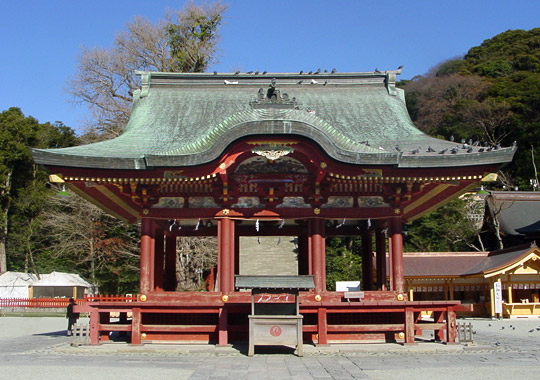|
||
 |
||

Tsurugaoka Hachimanguu Maidono 鶴岡八幡宮舞殿( Kanagawa)
(C)2001 Japanese Architecture and Art Net Users System. No reproduction or republication without written permission.
掲載のテキスト・写真・イラストなど、全てのコンテンツの無断複製・転載を禁じます。
|
||||||
| maidono 舞殿 | ||||||
| KEY WORD : architecture / shrines | ||||||
| Also read maiden. Also kaguradono, kaguraden 神楽殿 or kagura 神楽. Lit. dance hall. The structure where ritual dance and music are offered to the gods during shrine festivals. In the early Heian period, it was customary to perform in the open air or on a temporary platform. Outdoor entertainment in front of the shinden (see *shinden-zukuri 寝殿造) is illustrated in the Choukan gyoukou 朝かん行幸 (Royal Attendance) and Toukei 闘鶏 (Cock Fight) both found on the same scroll *Nenjuu gyouji Emaki 年中行事絵巻 (c.1157-79). The extant scroll is an Edo period copy. The earliest reference to a temporary dance stage is found in the mid-9c and refers to the maidono at Hirano Jinja 平野神社 in Kyoto. The temporary stage became a permanent feature about a century later. It had a roughly square roofed stage raised several steps above the ground, and was open on all four sides. Entrances could be placed on any side. When it became a permanent structure, its use was broadened to include the recitation of formal prayers. Gradually, its use as a worship hall took pre-eminence over its original purpose. According to some scholars, the maidono can be considered one of the antecedents of the worship hall called a *haiden 拝殿. Examples include: Kasuga Taisha Wakamiya Jinja Kaguraden 春日大社若宮神社神楽殿 (1613) in Nara; Nikkou Toushouguu Kaguraden 日光東照宮神楽殿 (1635-36) in Tochigi prefecture, and Kamo Mioya Jinja Maidono 賀茂御祖神社舞殿 (also called *Hashidono 橋殿); 1863) in Kyoto. | ||||||
 Tsurugaoka Hachimanguu Maidono 鶴岡八幡宮舞殿( Kanagawa)
|
||||||
| REFERENCES: | ||||||
| EXTERNAL LINKS: | ||||||
| NOTES: | ||||||
(C)2001 Japanese Architecture and Art Net Users System. No reproduction or republication without written permission. 掲載のテキスト・写真・イラストなど、全てのコンテンツの無断複製・転載を禁じます。 |
||||||